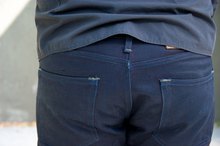What does fact checked mean?
At Healthfully, we strive to deliver objective content that is accurate and up-to-date. Our team periodically reviews articles in order to ensure content quality. The sources cited below consist of evidence from peer-reviewed journals, prominent medical organizations, academic associations, and government data.
- Current Reviews in Musculoskeletal Medicine: Coccydynia
- Current Reviews in Musculoskeletal Medicine: Coccydynia
- Medline Plus: Tailbone Trauma
The information contained on this site is for informational purposes only, and should not be used as a substitute for the advice of a professional health care provider. Please check with the appropriate physician regarding health questions and concerns. Although we strive to deliver accurate and up-to-date information, no guarantee to that effect is made.
What Are the Symptoms of a Bruised Tailbone?
Your tailbone, which is also referred to as the coccyx, is a portion of your spine that consists of the final three to five vertebrae at the base of your spinal column. A bruised tailbone occurs when this region of the body is damaged and can be caused by falling backward or by vaginal childbirth. See your doctor if you have symptoms of a bruised tailbone -- you may have a fracture or other underlying medical condition that needs further attention 1.
If you are experiencing serious medical symptoms, seek emergency treatment immediately.
Bruising
As the name of this medical condition implies, bruising is a primary symptom associated with a bruised tailbone. A bruise develops when the tissue beneath the surface of the skin is damaged and the top layer of skin remains intact (uncut or unbroken). You can notice that the skin near the base of your spine appears discolored and can initially become a dark red or purple color. As your bruised tailbone heals, the skin near the site of injury can temporarily change color to become blue, green or yellow, until it heals completely.
- As the name of this medical condition implies, bruising is a primary symptom associated with a bruised tailbone.
- As your bruised tailbone heals, the skin near the site of injury can temporarily change color to become blue, green or yellow, until it heals completely.
Pain
What Are the Symptoms of Torn Tendons?
Learn More
When you injure your tailbone, one of the first symptoms you can experience is pain within the lower portion of your back. Pain due to a tailbone injury can be persistent, making it difficult for you to sit or stand normally. Painful tailbone symptoms are typically localized to the site of injury but can extend across your lower back or up your spinal column. You may also experience difficulty walking after a tailbone injury, which can interfere with your ability to complete your normal daily activities.
- When you injure your tailbone, one of the first symptoms you can experience is pain within the lower portion of your back.
- You may also experience difficulty walking after a tailbone injury, which can interfere with your ability to complete your normal daily activities.
Swelling
Tissue injury due to a bruised tailbone can cause mild to moderate swelling at the base of your spine. You can notice that the skin at the site of injury appears puffy or enlarged. Swelling caused by a bruised tailbone can contribute to movement difficulties and typically occurs in conjunction with symptoms of pain, tenderness or bruising.
Constipation
Signs of Fibroid Degeneration
Learn More
A bruised tailbone can cause inflammation to develop within your lower back, which can extend into your intestinal tract. If this occurs, you may experience constipation as a symptom of a bruised tailbone. Constipation is a condition in which the normal production of a stool becomes painful, difficult or impossible. Additional symptoms associated with constipation can include abdominal pain, bloating or cramping.
- A bruised tailbone can cause inflammation to develop within your lower back, which can extend into your intestinal tract.
- Additional symptoms associated with constipation can include abdominal pain, bloating or cramping.
Related Articles
References
- NYU Langone Medical Center: Coccyx Fracture
- Current Reviews in Musculoskeletal Medicine: Coccydynia
- Medline Plus: Tailbone Trauma
- Blocker O, Hill S, Woodacre T. Persistent coccydynia--the importance of a differential diagnosis. BMJ Case Rep. 2011;2011:bcr0620114408. doi:10.1136/bcr.06.2011.4408
- Foye PM, Abdelshahed DM, Kamrava E, Enriquez R, D'onofrio GJ. Tailbone Pain from Coccyx Injuries on Water Slides: A Case Series. J Emerg Med. 2018;55(2):e33-e35. doi:10.1016/j.jemermed.2018.04.033
- Young JD, Gelbs JC, Zhu DS, Gallacher SE, Sutton KM, Blaine TA. Orthopaedic Injuries in Equestrian Sports: A Current Concepts Review. Orthop J Sports Med. 2015;3(9):2325967115603924. doi:10.1177/2325967115603924
- Márquez-carrasco ÁM, García-garcía E, Aragúndez-marcos MP. Coccyx pain in women after childbirth. Enferm Clin. 2019;29(4):245-247. doi:10.1016/j.enfcli.2019.01.005
- Gonnade N, Mehta N, Khera PS, Kumar D, Rajagopal R, Sharma PK. Ganglion impar block in patients with chronic coccydynia. Indian J Radiol Imaging. 2017;27(3):324–328. doi:10.4103/ijri.IJRI_294_16
- Faubion SS, Shuster LT, Bharucha AE. Recognition and management of nonrelaxing pelvic floor dysfunction. Mayo Clin Proc. 2012;87(2):187–193. doi:10.1016/j.mayocp.2011.09.004
- Uglialoro AD, Beebe KS, Hameed M, Benevenia J. A rare case of intraosseous benign notochordal cell tumor of the coccyx. Orthopedics. 2009;32(6):445. doi:10.3928/01477447-20090511-22
- Nunes LF, Castro Neto AK, Vasconcelos RA, et al. Carcinomatous degeneration of pilonidal cyst with sacrum destruction and invasion of the rectum. An Bras Dermatol. 2013;88(6 Suppl 1):59–62. doi:10.1590/abd1806-4841.20132140
- Dudareva M, Ferguson J, Riley N, Stubbs D, Atkins B, McNally M. Osteomyelitis of the Pelvic Bones: A Multidisciplinary Approach to Treatment. J Bone Jt Infect. 2017;2(4):184–193. doi:10.7150/jbji.21692
- Saleem S, Aslam HM, Rehmani MA, Raees A, Alvi AA, Ashraf J. Lumbar disc degenerative disease: disc degeneration symptoms and magnetic resonance image findings. Asian Spine J. 2013;7(4):322–334. doi:10.4184/asj.2013.7.4.322
- Jeyarajah S, Purkayastha S. Proctalgia fugax. CMAJ. 2013;185(5):417. doi:10.1503/cmaj.101613
- Lirette LS, Chaiban G, Tolba R, Eissa H. Coccydynia: an overview of the anatomy, etiology, and treatment of coccyx pain. Ochsner J. 2014;14(1):84–87.
- Malanga GA, Yan N, Stark J. Mechanisms and efficacy of heat and cold therapies for musculoskeletal injury. Postgrad Med. 2015;127(1):57-65. doi:10.1080/00325481.2015.992719
- Scott KM, Fisher LW, Bernstein IH, Bradley MH. The Treatment of Chronic Coccydynia and Postcoccygectomy Pain With Pelvic Floor Physical Therapy. PM R. 2017;9(4):367-376. doi:10.1016/j.pmrj.2016.08.007
- Antoniadis A, Ulrich NH, Senyurt H. Coccygectomy as a surgical option in the treatment of chronic traumatic coccygodynia: a single-center experience and literature review. Asian Spine J. 2014;8(6):705–710. doi:10.4184/asj.2014.8.6.705
- Foye PM. Coccydynia: Tailbone Pain. Phys Med Rehabil Clin N Am. 2017 Aug;28(3):539-49.
- Lirette LS, Chaiban G, Tolba R, Eissa H. Coccydynia: An Overview of the Anatomy, Etiology, and Treatment of Coccyx Pain. Ochsner J. 2014 Spring;14(1):84-87.
- Nathan ST, Fisher BE, Roberts CS. Coccydynia: a review of pathoanatomy, aetiology, treatment and outcome. J Bone Joint Surg Br. 2010 Dec;92(12):1622-7.
Writer Bio
Rae Uddin has worked as a freelance writer and editor since 2004. She specializes in scientific journalism and medical and technical writing. Her work has appeared in various online publications. Uddin earned her Master of Science in integrated biomedical sciences with an emphasis in molecular and cellular biochemistry from the University of Kentucky College of Medicine.








